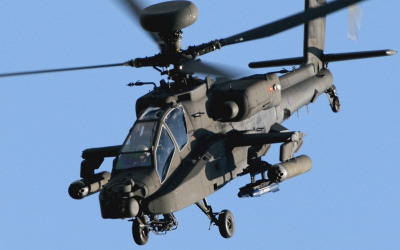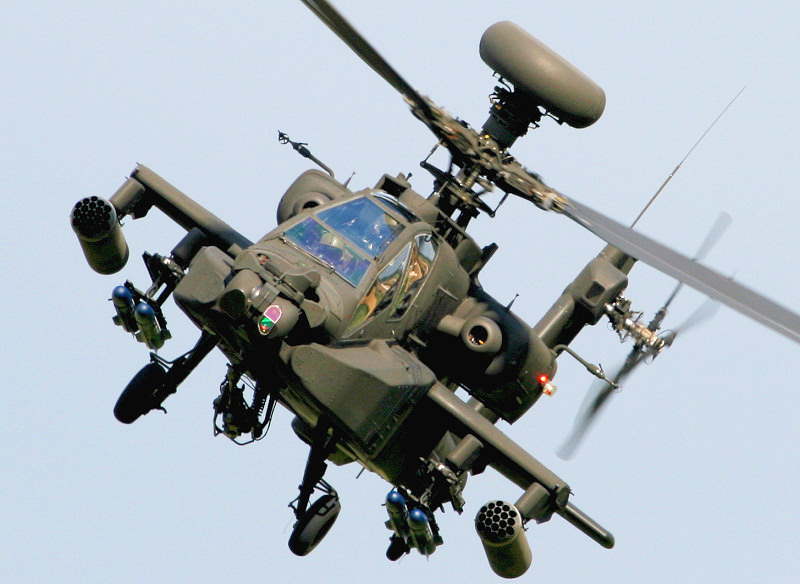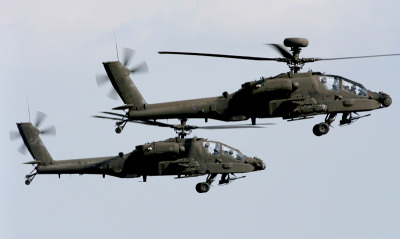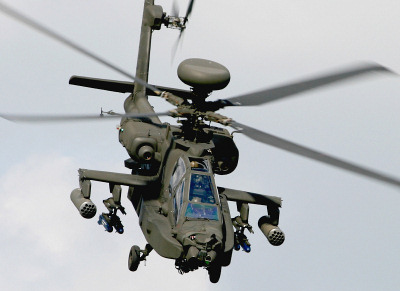Wattisham Airfield is located north-west of Ipswich in Suffolk.
It is home to 3 Regiment Army Air Corps and 4 Regiment Army Air Corps who are a part of the Attack Helicopter Force (AHF) within the Joint Helicopter Command (JHC), operating the AAC Apache AH1, along with the new remanufactured AH-64E Apache.
Wattisham Airfield Satellite View
Military Aircraft Tracker in the UK
 • Current Military Aircraft in the UK Tracker.
• Current Military Aircraft in the UK Tracker.
• Historic Military Aircraft in the UK Tracker.
• Military Aircraft around the World Tracker.
Live Trackers
When using ADS-B Exchange Tracker then click on 'U' to see military aircraft.
Scanner Frequencies
Wattisham Scanner Frequencies
Approach - 125.800, 389.225, *123.300
Director - 398.050, *123.300
Tower - 388.350, *122,100
PAR - 265.675, 386.725, *123.300
A/G - 125.800
ATIS - 277.925
*= NATO Common Frequency
|
Military Aircraft Photographs at UK Military Bases
Aircraft & Squadrons
Wattisham is home to 3 Regiment, 4 Regiment who are a part of the Attack Helicopter Force (AHF) within the Joint Helicopter Command (JHC), operating the AAC Apache AH1 & AH-64E.
3 Regiment AAC consists of 653 Squadron, 662 Squadron, and 663 Squadron, and 4 Regiment AAC consists of 656 Squadron, and 664 Squadron. 6 Regiment includes the Headquarters Squadron and 677 Squadron which provides ground support to the Apache Attack Helicopter.
3 Regiment:
653 Squadron - Apache AH64E
662 Squadron - Apache AH64E
663 Squadron - Apache AH64E
4 Regiment:
656 Squadron - Apache AH64E
664 Squadron - Apache AH64E
656 Sqn AAC are the last squadron to operate the older Apache AH1 and are expected to take part in an Apache AH1 Farewell Flypast on Monday 25th March 2024.
Fifty of the Apache AH1s are being remanufactured into the latest AH-64E Apache Guardian standard. The first two Apache AH-64E helicopters were delivered to Wattisham on 26th November 2020 via an RAF C-17 Globemaster III transporter. The remaining Apache AH-64E helicopters will be delivered over the next two years and will fly for the first time in the UK in July 2021.
Wattisham is also home to Royal Electrical and Mechanical Engineers (16 Air Assault Brigade) and the Royal Engineers (8 Engineer Brigade, 12 (Force Support) Engineer Group) with a helicopter repair facility with a worldwide capability (7 Aviation Close Support Battalion REME).
The Anglia Gliding Club, and 1287 Sqn, Air Training Corps are also based here. There is a museum (Wattisham Station Heritage) on site which tells the history of the airfield.
History
RAF Wattisham opened in 1939 as a medium bomber station using Bristol Blenheims, and later also Hurricanes, Fairey Battles, Douglas Bostons, Bristol Beaufighters and Airspeed Oxfords.
In September 1942 the base was handed over to the United States Army Air Force and work began on building concrete runways with the intention of adapting the airfield for heavy bomber use. It was later decided Wattisham would remain an air depot and also house a fighter unit. Work ceased on the runways and steel matting used to finish it off.
From October to December 1942, it was used by the Bell P-39D Airacobra. The Air Depot serviced many types of aircraft but, by late 1943, concentrated on fighter aircraft. More work was done to the airfield including hangars, technical area, hardstands, engineering complex, and taxiways. By 1944, Wattisham was responsible for the maintenance of all American fighters in the UK. Wattisham also hosted the 479th Fighter Group operating the P-38 Lightning by 1944.
In 1946, the base was returned to the Royal Air Force and the Gloster Meteor F.3 was operated from here in 1947. The Air Ministry Servicing Development Unit formed here on 1 January 1947, until 1950, with a number of aircraft including the Avro York I, Hawker Tempest V, Gloster Meteor F.4 & T.7, Avro Anson T.20 and the de Havilland Vampire F.3. In 1949, new runways were laid for the operation of jet fighters such as the Gloster Meteor and later Hawker Hunters in 1954.
The Royal Air Force's display team, the Black Arrows, was added to Wattisham's roster, flying the Hunters. Air displays were a regular feature from 1959.
During the Cold War in the late 1950s, Wattisham was home to the English Electric Lightning which operated from Quick Reaction Alert Sheds to counter threats from the east. The Lightnings were eventually replaced by the McDonnell Douglas Phantoms in 1974 which continued defending Britain's airspace until the end of the Cold War in 1992.
With the Cold War threat gone it was no longer needed by the RAF. Wattisham stood down as a fighter base on 31 October 1992 and was handed over to the British Army in March 1993. The Army Air Corps soon moved in and it rapidly became a major Army airfield. The Royal Air Force returned to operate Westland Sea King Search and Rescue helicopters on the site of the former QRA hangars. The Sea King Search and Rescue (SAR) helicopters were stood down in 2015 with the privatisation of SAR.


 AAC Apache.
AAC Apache.
 AAC Apache.
AAC Apache.
 AAC Apaches.
AAC Apaches.
 AAC Apache.
AAC Apache.
